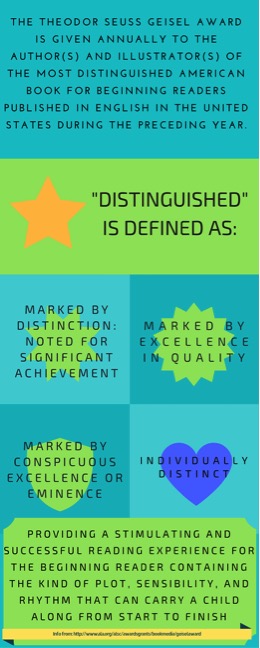Today's guest contributor is Elisa Gall. Elisa is the Director of Library Services at an independent school in Chicago serving children in preschool through high school. Find her on Twitter @gallbrary.
I’ve been thinking about the word "distinguished" lately. It is no stranger to ALSC award language, and no matter how much the association goes out of its way to define it (see graphic) it can still seem ambiguous. One person’s perceived flaw for a book can be that same thing which makes a book "individually distinct" to another committee member. But it is true (to me at least) that a book cannot be a serious contender for the award if it does not fit all the elements of the "distinguished" definition.
In Pug by Ethan Long, readers follow a wide-eyed pug (named "Pug") as it looks pleadingly out the window at "Peg" on a snowy day. When Pug sees Peg, readers see a bundled-up girl walking through the neighborhood. Pug yaps at each member of its family (with leash nearby) to hint that it would like to be outside. Only when Tad, the kid of the family, fears that Pug will have an accident on his bed does he reluctantly leave the cozy house to fulfill Pug’s request. When Tad and Pug meet Peg, it is revealed that Peg is the pet pug of the girl who has been walking through the snow, and not the girl readers have seen (and who Tad later befriends).
Using twelve unique words, Long presents an engaging and accessible story. Sentences average three words each, and the polished digital illustrations are full of bold lines that appropriately match the text’s large, clear font. Words and images work in tandem, but readers must make some inferences. When the dogs communicate through yaps, for example, the sounds are color coded to represent which animal is barking. Readers even see Peg’s yaps when she is not shown on the page. (Pug’s ear is in the air to show that the noises are coming from somewhere unseen.) As words are repeated, they take on deeper meaning too. For example, after Pug lifts its back leg into the air (and Tad says, "No, Pug, No.") readers turn the page and see Tad and Pug outside, with the words "Go, Pug, go." accompanying them. The "go" on this page can mean Pug is going outside, but there is another (more humorous) type of "go" that it can also represent.
Some critics might argue that it might be confusing for an emergent reader to see Peg revealed as a dog (and not the girl previously shown) in the story’s surprise ending. They might point to the part of the Geisel criteria that states, "illustrations must demonstrate the story being told." I would ask someone with these concerns to consider how that final revelation does tell the story—through images. I would ask them to think about how many works of visual narrative use complicated and in some cases contradictory images and words to tell their stories. Pug is a beginning reader for children who are learning to read a book’s text, pictures, and everything in between. It is a reader for both traditional literacy and visual literacy. To me, that makes it "individually distinct" and worthy of the debatable "distinguished" category. What do you all think?



No comments:
Post a Comment
Note: Only a member of this blog may post a comment.